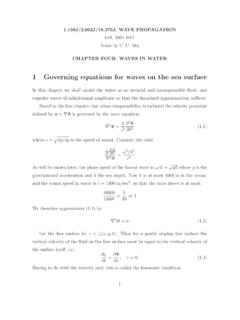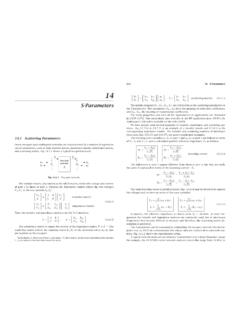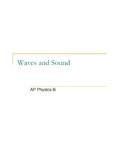Transcription of SEISMIC WAVES PRACTICE QUESTIONS - Mr. Romano
1 SEISMIC WAVES PRACTICE QUESTIONS Base your answer to question 1 on the diagram below, which shows models of two types of earthquake WAVES . 1. Model A best represents the motion of earthquake WAVES called (1) P- WAVES (compressional WAVES ) that travel faster than S- WAVES (shear WAVES ) shown in model B (2) P- WAVES (compressional WAVES ) that travel slower than S- WAVES (shear WAVES ) shown in model B (3) S- WAVES (shear WAVES ) that travel faster than P- WAVES (compressional WAVES ) shown in model B (4) S- WAVES (shear WAVES ) that travel slower than P- WAVES (compressional WAVES ) shown in model B Base your answer to question 2 on the cross section below, which shows the paths of SEISMIC WAVES traveling from an earthquake epicenter through the different layers of Earth s interior.
2 2. S- WAVES are not received on the side of the Earth opposite from the earthquake epicenter because (1) P- WAVES cannot travel through the solid inner core. (2) S- WAVES cannot travel through the liquid inner core. (3) P- WAVES cannot travel through the solid outer core. (4) S- WAVES cannot travel through the liquid outer core. 3. The distance from Kngston, New York, to the epicenter of this earthquake is 2600 km. Approximately how much longer did it take for the S-wave to arrive at Albany than the P-wave? (1) 4 minutes and 00 seconds (3) 7 minutes and 20 seconds (2) 5 minutes and 10 seconds (4) 9 minutes and 10 seconds 4. A seismograph station recorded the arrival of the first P-wave at 7:32 from an earthquake that occurred 4000 kilometers away.
3 What time was it at the station when the earthquake occurred? (1) 7:32 (3) 7:25 (2) 7:20 (4) 7:39 5. Which statement correctly compares SEISMIC P- WAVES with SEISMIC S- WAVES ? (1) P- WAVES travel faster than S- WAVES and pass through Earth s liquid zones. (2) P- WAVES travel faster than S- WAVES and do not pass through Earth s liquid zones. (3) P- WAVES travel slower than S- WAVES and pass through Earth s liquid zones. (4) P- WAVES travel slower than S- WAVES and do not pass through Earth s liquid zones. 6. The map below shows the location of an earthquake epicenter in New Y York State. SEISMIC stations A, B, and C received the data used to locate the earthquake epicenter. The seismogram recorded at station A would show the (1) arrival of P- WAVES , only (2) arrival of S- WAVES before the arrival of P- WAVES (3) greatest difference in the arrival times of P- WAVES and -S- WAVES (4) earliest arrival time of P- WAVES 7.
4 An earthquake earthquake s first s P-wave arrives at a SEISMIC station at 12:00:00. This P-wave has traveled 6000 kilometers from the epicenter. At what time will the first S-wave from the same earthquake arrive at the SEISMIC station? (1) 11:52:20 (3) 12:09:20 (2) 12:07:40 (4) 12:17:00 8. An earthquake s magnitude can be determined by (1) calculating the time the earthquake occurred (2) calculating the depth of the earthquake faulting (3) analyzing the SEISMIC WAVES recorded by a seismograph (4) comparing the speed of P- WAVES and S- WAVES 9. A SEISMIC station is recording the SEISMIC WAVES produced by an earthquake that occurred 4200 kilometers away. Approximately how long after the arrival of the first P-wave will the first S-wave arrive?
5 (1) 1 min 05 sec (3) 7 min 20 sec (2) 5 min 50 sec (4) 13 min 10 sec 10. A P-wave takes 8 minutes and 20 seconds to travel from the epicenter of an earthquake to a SEISMIC station. Approximately how long will an S-wave take to travel from the epicenter of the same earthquake to this SEISMIC station? (1) 6 min 40 sec (3) 15 min 00 sec (2) 9 min 40 sec (4) 19 min 00 sec 11. A SEISMIC station 7000 kilometers from the epicenter of an earthquake records the arrival time of the first P-wave at 10:00:00. At what time did the first S-wave arrive at this station? (1) 9:51:30 (3) 10:19:00 (2) 10:08:30 (4) 10:10:40 12. How long would it take for the first S-wave to arrive at a SEISMIC station 4,000 kilometers away from the epicenter of an earthquake?
6 (1) 5 min 40 sec (3) 12 min 40 sec (2) 7 min 0 sec (4) 13 min 20 sec 13. A SEISMIC station recorded an earthquake with an epicenter distance of 4,400 kilometers. If the origin time of the earthquake was 11:00 , what time did the P-wave arrive at the SEISMIC station? (1) 10:52:20 (3) 11:07:40 (2) 11:05:00 (4) 11:12:00 14. The seismogram shows the time that an earthquake P-wave arrived at a SEISMIC station n Albany, New York. If the earthquake occurred at exactly 10:04 , approximately how far from the earthquake epicenter was Albany, New York? (1) 1,800 km (3) 4,000 km (2) 1,400 km (4) 4,800 km Base your answers to QUESTIONS 15 and 16 on the diagrams below. Diagram 1 represents a cross section of Earth and its interior layers.
7 The asterisk ( * ) shows the location of an earthquake epicenter. Letters A through D are SEISMIC stations on Earth s surface. Diagram 2 shows four seismograms labeled I, II, III, and IV, which were recorded at SEISMIC stations A, B, C, and D during the same time interval. 15. Which list correctly matches the seismograms with the SEISMIC stations where they were recorded? (1) seismogram I station A (2) seismogram I station C (3) seismogram I station B (4) seismogram I station A seismogram II station B seismogram II station B seismogram II station D seismogram II station D seismogram III station C seismogram III station D seismogram III station A seismogram III station B seismogram IV station D seismogram IV station A seismogram IV station C seismogram IV station C 16.
8 Station D is 8000 kilometers from the earthquake epicenter. How long did it take for the first P-wave to travel from the epicenter to station D? (1) 9 minutes 20 seconds (3) 20 minutes 40 seconds (2) 11 minutes 20 seconds (4) 4 minutes 20 seconds 17. The seismogram below shows P-wave and S-wave arrival times at a SEISMIC station following an earthquake. The distance from this SEISMIC station to the epicenter of the earthquake is approximately (1) 1,600 km (3) 4,400 km (2) 3,200 km (4) 5,600 km 18. If a seismograph recording station located 5,600 kilometers from an epicenter receives a P-wave at 4:45 , at which time did the earthquake actually occur at the epicenter? (1) 4:24 (3) 4:36 (2) 4:29 (4) 4:56 Base your answers to QUESTIONS 19 and 20 on the data table below, which gives information collected at SEISMIC stations A, B, C, and D for the same earthquake.
9 Some of the data has been deliberately omitted. 19 What is the approximate distance from station C to the earthquake epicenter? (1) 3,200 km (3) 1,600 km (2) 2,400 km (4) 1,000 km 20. How long did it take the P-wave to travel from the epicenter of the earthquake to SEISMIC station D? (1) 00:46:20 (3) 00:17:20 (2) 00:39:20 (4) 00:09:40









